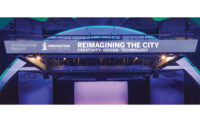Our relationship to the city has been changed much more by information technology than architectural technology,” said curator and Domus magazine editor Joseph Grima, introducing a panel at the Ideas City conference in New York last week. While the basic vocabulary of the city of vertical towers has remained fairly constant for the last hundred years, he continued, what people demand from that landscape has transformed dramatically.
His remark was one of many that underscored the “Untapped Capital” theme of this year’s Ideas City festival, the second iteration of a biennial series of urban-focused events organized by the New Museum in Manhattan. It began with the conference, included a series of workshops in a nearby historic school building, and culminated with a day-long street fair showcasing more than 120 organizations, the majority of which presented modern ways of improving old-style cities that made use of underused, overlooked, or discounted resources.
The conference set the intellectual tone for the event. Held in Cooper Union’s Great Hall (amid protests against the school beginning to charge undergraduate tuition), it included a keynote talk by MIT Media Lab director Joi Ito and a varied schedule of well-curated panels, from discussions about waste, play, and youth to a conclave of current and former mayors.
At the street fair, held on Saturday, things got messier. The exhibitors set up in strings of temporary booths—and a couple of mirror-clad, gable-roofed pavilions by Davidson Rafailidis Architecture—on the blocks surrounding the New Museum’s SANAA-designed building and in nearby Sara D. Roosevelt Park. The projects ranged from the ambitious, such as an organization called Bus Roots’s plan to create green roofs on top of busses (complete with a drivable prototype), to the practical, including the Center for Urban Pedagogy’s well-designed publications, to the hilarious, see the Institute for Creative Destruction’s booth offering destruction consultations from deadpan attendants in white lab coats.
The event had the atmosphere of a science fair crossed with a carnival. Detritus-heavy performances neighbored earnest D.I.Y. projects and established nonprofits. Some ideas were better organized, more feasible, or just more inspiring than others, but exploring the mix gave an excellent sense of the variety of work going on out there and offered a chance to meet the impassioned people behind the projects.
There were also some examples of more traditional architecture and planning. Alexander Gorlin was on hand in his firm’s booth showing plans to improve public housing in Lower Manhattan. Columbia University, Cooper Union, and Princeton University each presented research-based projects on the future of the New Museum’s Bowery neighborhood.
After the event, the museum took some heat for the removal of eight placards, which criticised the art world's role in gentrifying the once notoriously gritty area, from the wall of the neighboring Bowery Mission shortly before the street fair began. A New Museum spokesperson says that the Mission, not the museum, removed the posters.
The festival concluded on Saturday night with a series of performances, including one involving giant white orbs designed by the New York firm Snarkitecture. But through July 7, Adhocracy, a concurrent exhibition curated by Grima, presents 25 mostly technology-focused projects in an storefront annex next to the museum. Like the work presented during the festival, the exhibition demonstrates that while our cityscapes may look similar to how they did a century ago, the ways that we use them continues to evolve.











Post a comment to this article
Report Abusive Comment